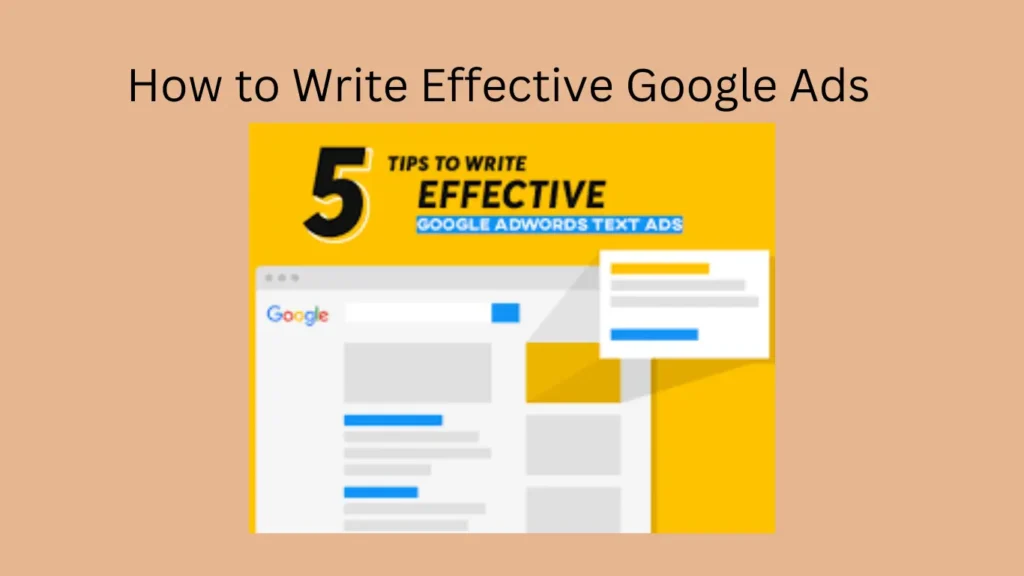Creating effective Google Ads is essential for maximizing your online marketing efforts. An effective ad not only attracts clicks but also drives conversions. This guide will walk you through the process of crafting Google Ads that are engaging, reliable, and people-first.
Understanding the Basics of Google Ads
Google Ads is a pay-per-click (PPC) advertising platform that allows you to create ads that appear in Google search results and across the Google Display Network. The main components of a Google Ad include:
- Headlines: Up to three, each with a 30-character limit.
- Descriptions: Up to two, each with a 90-character limit.
- Display URL: Shows your website address.
- Path Fields: Two optional fields, each with a 15-character limit, to add more context to your URL.
Tips for Writing Effective Google Ads
1. Know Your Audience
Understanding your target audience is the foundation of any successful ad campaign. Consider the following:
- Demographics: Age, gender, location, etc.
- Interests: What are their hobbies, preferences, and pain points?
- Search Intent: What are they looking for, and how can your product or service fulfill their needs?
2. Craft Compelling Headlines
Your headlines are the first thing users see. Make sure they are:
- Clear and Concise: Quickly convey your message.
- Keyword-Rich: Include relevant keywords to improve ad relevance.
- Engaging: Use action words and offer a solution or benefit.
Example: “Affordable Wedding Photography – Book Now!”
3. Write Persuasive Descriptions
Descriptions give you more space to expand on your offer. Ensure they are:
- Informative: Highlight key features and benefits.
- Engaging: Encourage users to take action with a strong call to action.
- Relevant: Ensure the description aligns with the headline and the user’s intent.
Example: “Capture your special moments with our professional wedding photography. Book today and save 20%.”
4. Use Path Fields Effectively
Path fields help users understand what to expect when they click your ad. They should be:
- Relevant: Closely related to your ad and landing page content.
- Descriptive: Add more context to your URL.
Example: “Wedding/Photography”
5. Incorporate a Strong Call to Action
A strong call to action (CTA) tells users what to do next. Use action verbs and create a sense of urgency.
Example: “Shop Now,” “Get Started,” “Learn More”
Best Practices for Google Ads
- Keep It Simple: Avoid jargon and complex language.
- Test Variations: A/B test different headlines, descriptions, and CTAs to see what works best.
- Use Ad Extensions: Enhance your ads with additional links, call buttons, location info, and more.
- Focus on Benefits: Highlight how your product or service solves a problem or meets a need.
- Maintain Relevance: Ensure your ad copy is closely related to your landing page content.
Common Mistakes to Avoid
- Overstuffing Keywords: Use keywords naturally and avoid overloading your ad.
- Ignoring Mobile Users: Ensure your ad looks good on mobile devices.
- Neglecting Ad Extensions: Take advantage of ad extensions to provide more information and options to users.
- Weak CTAs: Make sure your CTA is strong and compelling.
- Not Updating Ads: Regularly review and update your ads to keep them fresh and relevant.
Conclusion
Writing effective Google Ads is both an art and a science. By understanding your audience, crafting compelling headlines and descriptions, and using clear calls to action, you can create ads that not only attract clicks but also drive conversions. Remember to keep your content helpful, reliable, and people-first, ensuring your ads resonate with your audience and meet their needs. Follow these guidelines, and you’ll be well on your way to creating successful Google Ads campaigns.
For further Inquires Contact Us
FAQs
What are the key components of a Google Ad?
The key components of a Google Ad include headlines, descriptions, display URL, and optional path fields. Each element has specific character limits to ensure concise messaging.
How do I make my Google Ad headlines compelling?
To make your Google Ad headlines compelling, use clear and concise language, include relevant keywords, and add engaging action words or benefits to attract attention.
What should I include in the description of my Google Ad?
Include key features and benefits of your product or service, use complete sentences for clarity, and incorporate a strong call to action to encourage user engagement.
Why is a strong call to action important in Google Ads?
A strong call to action is important because it tells users what to do next, creating a sense of urgency and guiding them towards taking the desired action, such as clicking your ad or making a purchase.
What are common mistakes to avoid when writing Google Ads?
Common mistakes include overstuffing keywords, neglecting mobile users, not using ad extensions, having weak CTAs, and failing to regularly update ads to keep them fresh and relevant.
